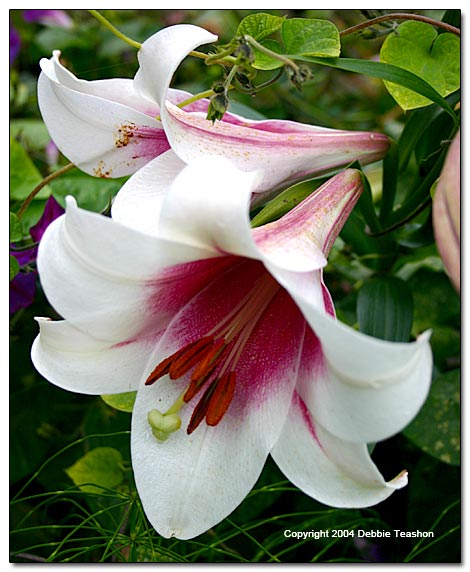Lilium 'Triumphator'
LONGIFLORUM/ORIENTAL HYBRID
Family: Liliaceae
Pronounced: LEE-lee-um
Quick Jumps
Growing Guide
Rainy Side Notes
GROWING GUIDE

Origin:
Garden.
Plant Group:
Bulbs.
Hardiness:
Sunset zones: All (western PNW zones).
USDA zones: 5-9.
Mature size:
Height: 3-4 feet (1-1.2 m).
Flowering period:
July/August.
Flowering attributes:
Fragrant, white, 6-inch, trumpet-shaped flowers with pinkish-red throats and streaks of pinkish red on the outside with up to 20 per stem.
Light:
Full sun to partial shade.
Soil:
Although not particular about soils, I grow mine in humus rich, moist, well-drained soil.
Feeding:
In spring, when lilies are at the spear stage of growth (like asparagus), fertilize with a complete organic fertilizer. Do not feed again for the rest of the year; excessive fertilizing can promote disease and soft growth.
Propagation Methods:
As soon as the foliage dies back, dig bulbs and remove scales, bulbils and offsets from bulb; immediately replant.
Pruning Methods:
Remove dried stems only after foliage dies back.
Pests and Diseases:
Slugs may be a problem when plants begin growth in spring.
Rainy Side Notes
Even though the flower looks more like a trumpet lily, Lilium 'Triumphator' is a cross between the Oriental and Longiflorum species.
In my opinion, the bulb should take over the job as the official Easter lily. Statuesque at 4 feet tall, bearing as many as 20 fragrant flowers on a stem, it packs a punch with wow factor! After forcing it for the spring holiday, you could plant this in the ground and have it come back every year in the Pacific Northwest. A bunny can dream, right?
Cut flowers when the first flower is just beginning to open. The flower lasts from 5-9 days in the vase. Pull the pollen sacks off when the flower opens to keep pollen from staining linens beneath the vase. If pollen should get on clothes or linens, let it dry before wiping it off. If wiped when wet, the pollen will stain.
To grow lilies well, mulch with composted manures or compost and shredded bark to keep the roots cool while adding humus to the soil. When you receive the bulbs, plant them quickly as they don't keep well out of the ground.
Photographed in author's garden.

Gardening for the Homebrewer: Grow and Process Plants for Making Beer, Wine, Gruit, Cider, Perry, and More
By co-authors Debbie Teashon (Rainy Side Gardeners) and Wendy Tweton
Copyright Notice | Home | Search | Bulbs

